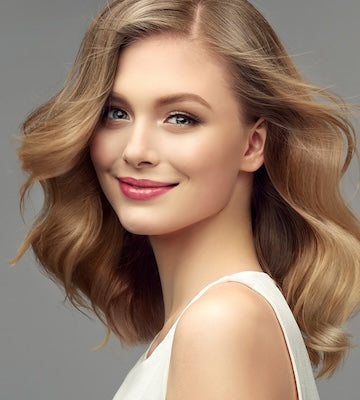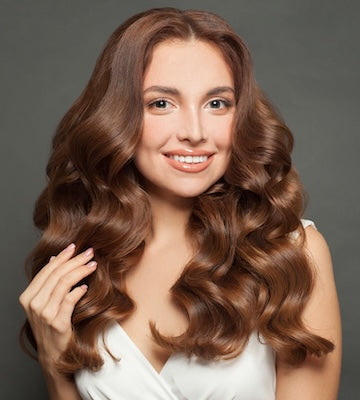If you’ve ever wondered why your hair behaves beautifully one month and then completely differently the next, you’re not alone. Our hair, like our skin, is sensitive to our environment. So, what’s going on?
Many women notice real, seasonal changes in their hair. One month, it might feel flat and weighed-down. The seasons change, and it gets frizzy beyond control. And just when you’ve got your routine figured out? The weather changes again.
Temperature shifts, humidity, UV exposure and indoor heating all affect the scalp and hair structure, often in ways we don’t expect. So if your usual routine isn’t quite working anymore, it could be the weather.
In this article, we explain how the seasons affect your hair and scalp, how to adjust your care routine gently and naturally - and feel confident in your hair. Whatever the weather.
Does your hair change with the seasons?
Yes, it really does, and science backs this up.
Just like animals go through seasonal moults, humans also experience changes in hair growth, texture and shedding depending on the time of year. Your scalp is full of tiny hair follicles, each in its own growth cycle. Environmental cues like daylight length, temperature and hormone levels all impact these cycles.
For example:
- In summer, you might notice faster growth, more oil production or increased frizz
- In winter, hair may become drier, more brittle or harder to style
- During spring and autumn, changes in light and temperature can trigger increased shedding or scalp sensitivity
These are natural responses. But they can still feel frustrating if you're not sure what’s happening (or trying to perfect that all-important summer wedding hairstyle!). That’s why adapting your routine with each season makes such a difference.
How do different seasons affect your hair and scalp?
At the root of it all, quite literally, is your scalp. Your scalp is living tissue, full of tiny structures called hair follicles, which each go through a growth cycle. These follicles are highly sensitive to changes in light, temperature and humidity. As the environment around you changes, your scalp and follicles adjust.
Let’s start with an overview.
Spring
Spring is a transition period, and your body often sheds more hair as part of the natural growth cycle. This happens during the telogen phase, when older strands fall out to make way for new ones. It’s not a sign that something’s wrong. It’s your scalp’s way of hitting refresh.
Summer
Hot weather brings UV exposure, humidity, sweat and saltwater. All of these can stress the hair and scalp. For instance, UV rays weaken keratin and lipids (your hair’s main protein and protection barrier), while sweat and SPF can clog follicles, leading to irritation or a flaky scalp in summer.
Autumn
Autumn often brings a second wave of shedding. Shorter days can disrupt the scalp’s oil production and lower vitamin D levels, both of which affect the hair growth cycle. It’s common to notice more hair in your brush around this time, even if you haven’t changed anything.
Winter
In winter, cold air outside and dry central heating inside draw moisture from your scalp and strands. This often results in brittleness, static and a dry scalp in winter. Sebum (natural oil) production drops, and the scalp barrier can become more sensitive, especially with frequent hot showers or harsh cleansers.
Summer Hair Care: Sun, Sweat and Scalp Balance
While warmer weather can support faster hair growth thanks to increased circulation and vitamin D exposure, it also brings challenges: UV rays, sweat and humidity.
Let’s break it down.
How does summer affect your hair?
Hair care for summer is all about balance. While it’s a season full of sunshine, social plans and longer days that can lift your mood and boost hair growth, it also brings stressors for your scalp and strands.
Here’s what can happen:
-
UV rays break down the protein structure of hair (keratin), leaving it dry and fragile
-
Humidity causes the hair shaft to swell and the cuticle to lift, making hair frizzy or difficult to manage
-
Sweat and SPF can irritate the scalp, clog follicles, or lead to a flaky scalp in summer if not cleansed with gentle shampoos and conditioners
- Extra washing to feel fresh can strip away natural oils, leaving the scalp imbalanced
That’s why smart, gentle hair care in the summer season isn’t just about keeping hair looking good. It’s about supporting the scalp too.

Does hair get more frizzy in summer?
Yes, and there’s a scientific reason for it. Hair is “hygroscopic”, which means it absorbs moisture from the air. In humid conditions, this causes the outer cuticle layer to swell and lift. That uneven texture? It’s frizz.
To combat it:
- Use summer hair products that lock in moisture and smooth the cuticle. Like leave-in conditioners and sealing hair oils
- Swap heavy styling products for lightweight, anti-humidity formulas that won’t weigh you down
- Avoid over-brushing, which worsens frizz. Use a wide-tooth comb or fingers instead
Is it normal to lose more hair during summer?
Surprisingly, yes. Some women experience seasonal telogen effluvium, a type of temporary shedding triggered by seasonal changes. It’s triggered by shifts in daylight and temperature, and tends to show up in late summer.
If you’re noticing extra strands, you’re not doing anything wrong. But if hair loss is worrying you, there are gentle ways to encourage healthy regrowth:
-
Focus on scalp care. Try a lightweight scalp oil or exfoliating treatment to gently cleanse and nourish the follicles. A healthy scalp creates the right environment for hair to grow back stronger
-
Make sure your diet is nutrient-rich. Specifically focus on vitamins and minerals like iron, biotin and zinc (which all contribute to healthy hair)
- Take time to de-stress. Chronic stress makes shedding worse. Of course, this is easier said than done, but activities like yoga, meditation or positive affirmations can all help
Does hot weather make hair flat?
Absolutely. If you’re struggling to keep that bouncy half-up, half-down style from drooping by midday, you’re not alone.
In hot weather, your scalp produces more sweat and oil, both of which can weigh down the roots - especially if your hair is fine or naturally straight. Add humidity into the mix, and even the most volumised styles can fall flat.
To bring back some lift and freshness, try a root-refreshing spray or a light dry shampoo. These absorb excess moisture without drying out your scalp. Avoid heavy conditioners, and try rinsing your hair with cool water at the end of your shower. This helps seal the hair cuticle, reducing frizz and moisture-loss.
Winter Hair Care: Cold, Dry Air & Moisture Rescue
Winter might not look as harsh on your hair as summer, but it often causes more trouble than you expect. Cold, dry air outside combined with central heating indoors can leave your hair rough and your scalp feeling tight or more sensitive than usual.
That’s because cold air holds far less moisture - and heating only dries things out more. The result? Dehydrated strands that lose elasticity, snap easily, and a scalp that struggles to stay balanced.
But the good news is winter season hair care doesn’t need to be complicated. Just gentle, consistent and deeply moisturising.
Does hair get more damaged in winter?
While summer brings obvious stressors like UV rays, chlorine and heat, winter damage tends to build up more subtly. Cold air outside and central heating indoors both strip moisture from your hair and scalp. Over time, this can leave strands brittle, rough at the ends, and more prone to static or breakage.
To protect your hair, add gentle yet effective techniques to your winter hair care routine:
-
Deep condition weekly with a nourishing mask (look for high-performing ingredients like argan oil, biotin and keratin)
-
Seal in moisture with a lightweight leave-in conditioner or hair oil, especially before going out
-
Use a microfibre towel to reduce friction when drying. Also consider whether your hats, scrunchies, scarves or heavy coats are causing additional friction
- Try protective heat-free styles like braids, buns, or silk-lined hats to reduce tangling and breakage
Does cold weather affect your scalp?
Absolutely. Your scalp is still skin, and just like your face or hands, it’s vulnerable to winter dryness. In winter, low humidity pulls moisture from the outermost layer of your skin, which compromises the scalp’s barrier function.
This can lead to “increased transepidermal water loss” (TEWL). In other words, your scalp loses more water than usual, leaving it dehydrated and irritated.
For those with eczema or psoriasis, winter often worsens symptoms. But the answer isn’t harsher washing, it’s gentler care.
What helps:
- Hydrating scalp oils or serums once or twice a week, with calming, natural ingredients
- Lukewarm showers to preserve natural oils
- Gentle scalp massage to stimulate circulation, reduce stress and support healthy growth
Should I wash my hair more or less in winter?
In winter, most people find that washing less is better. The cold slows down your scalp’s oil production, and frequent washing (especially with hot water or harsh shampoos) can strip away what little moisture is left. That’s often when dryness, irritation or flakiness sets in.
Try spacing out your wash days and using dry shampoo or a light rinse in between. If you have curly or coily hair, co-washing (using conditioner instead of shampoo) can be a great way to cleanse gently while keeping hydration locked in. And whatever your hair type, sulphate-free, moisturising formulas will go a long way in protecting both scalp and strands.
With the right support, winter doesn’t have to be a season of damage or frustration. Whether you’re dealing with dryness, flaking or breakage, there are simple, science-backed ways to adapt - and help your hair feel strong, soft and beautifully cared for.
What’s the best season for hair growth?
As a rule, late spring and early summer are the peak times for hair growth. And when you think about it, it makes sense! Why? Well, warmer weather tends to boost circulation, we spend more time outdoors, and our bodies start to feel more energised after the slower pace of winter.
Here’s what’s going on behind the scenes:
-
Improved circulation: Warmer temperatures can improve arterial health, increasing blood flow to the scalp. This delivers more oxygen and nutrients to the follicles. Exactly what your hair needs to grow strong and healthy
-
More sunlight: Exposure to sunlight boosts vitamin D production, which plays an important role in stimulating dormant hair follicles and supporting new growth
- Melatonin shifts: As the days get longer, melatonin levels naturally adjust. Melatonin doesn’t just help regulate sleep. It also influences hair growth cycles and reduces hair loss
But, it’s not quite that simple. As we’ve seen, this same period can trigger seasonal shedding, often due to changes in hormone levels, daylight exposure, or even residual stress from winter. So while it’s true that many people experience faster growth in late spring and summer, it can also be a time when your scalp sheds older strands to make way for new ones.
In short, hair growth is a cycle, and seasonal effects are just one layer. The most powerful support you can offer your hair - whatever the weather - is a consistent routine: nourishing your body, caring for your scalp and creating space for rest and renewal.
Phoenix Crown: here for every season and every strand
From gentle styling accessories to science-backed hair care and luxurious 100% natural Virgin human hair extensions that blend seamlessly and effortlessly, our range is built to support your beauty. Rain or shine.
Because when you feel good in your hair, you feel good full stop.
And that’s something we care about. Season after season.










